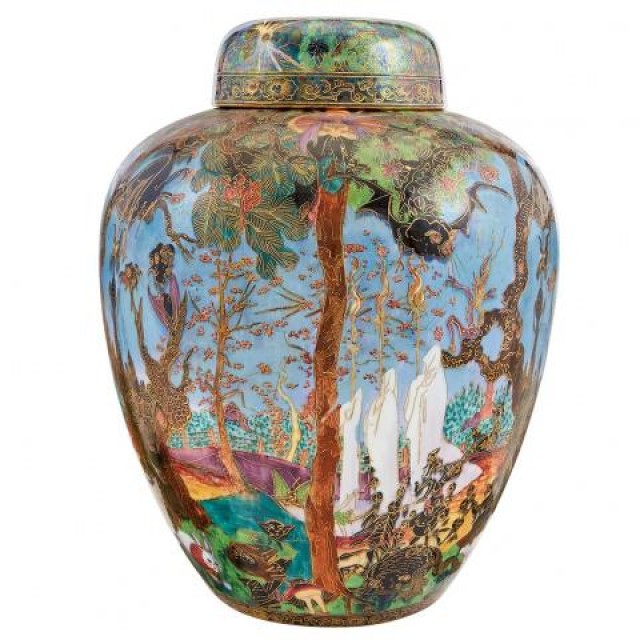Fairyland Fantasy
05/31/2017 Furniture & Decorative Arts

NEW YORK, NY -- Wedgwood ceramics are synonymous with classic and traditional design, however the firm also developed some of the most colorful jewel-toned and ornately decorated ceramic wares. Wedgwood was founded in 1759 by Josiah Wedgwood (1730-1795) in Stoke-on-Trent, England. After much experimentation, Josiah Wedgwood produced three well-known ceramic compositions for Wedgwood: Queen’s Ware in 1762, Black Basalt in 1768, and Jasper in 1774. Remembered as the “Father of English Potters,” Wedgwood turned English pottery into an international industry. Perhaps the most famous of the Wedgwood designs, Jasperware is an unglazed vitreous stoneware made in a variety of colors, although the iconic “Wedgwood blue” is the most recognizable. During the 19th century, Wedgwood needed a new innovation and energy that had faded.
While classical forms and decorations, as well as subdued colors, kept Wedgwood afloat from the 18th through the early 20th century, they also began to break away from tradition by hiring freelance artists to develop new designs for the classical shapes. However by the beginning of the 20th century, the factory faced bankruptcy. To combat difficult financial times with the onset of World War I, Wedgwood targeted the luxury and elite market with products featuring fanciful scenes and bright colors.
Susannah Margaretta “Daisy” Makeig-Jones (1881-1945) started at Wedgwood in 1909 as an apprentice and rose through the ranks before getting her own design studio and becoming one of the company’s foremost designers. It was Makeig-Jones’s imagination and innovation that brought Wedgwood again to the forefront of English pottery with her technical achievements in ceramic production and design.
Makeig-Jones’s fascination with fairies took inspiration from some of the best illustrators in the golden age of illustration, including Arthur Rackham, Edmund Dulac and Danish artist Kay Nielsen. She also looked to literature and folklore, as well as Oriental and exotic scenes, frequently set in wooded landscapes.
The first of her Fairyland patterns began with the Poplar Trees design in 1916-17 as an imaginative escape from the horrors of war. Often the decorations included landscapes, elves, fairies and gnomes, and silhouetted figures on forms having traditional shapes. The variety of stories appear overwhelming at first, but the closer one looks at each Fairyland lustre ware, individual vignettes can be seen: elves playing leapfrog, spiders, wise owls, etc.
The malfrey pot to be offered in the Doyle+Design auction on June 7, 2017 (Lot 289) depicts illustrations from Lewis Carroll’s Alice in Wonderland and The Legend of Croquemitaine illustrated by Gustave Doré, which tells the story of Charlemagne and his knights. In the legend, the goddaughter of Charlemagne, Mitaine, traversed through the Land of Illusion while trying to reach the Fortress of Fear. In our example, ghostly figures walk toward trees with demon heads. Other characters including the hideous toad and Yellow Dwarf can be found on the journey towards the Fortress of Fear.
Makeig-Jones completed her own test firings with different colored glazes and lustres. To create the elaborate decorations, engravers would transfer Makeig-Jones’s designs to copper plates and then print them onto paper sheets called pottery tissues. Before the ink dried on the tissues, the design imprint was rubbed on the surface of the ceramic. Women painters applied the underglaze enamel colors, which often entailed several coats and up to six firings in the kiln, before adding the overglaze enamels as highlights. Gilded details were added as a last step. The mixture of gold, silver, and copper metallic-oxide pigments created a shimmering iridescent effect.
The Fairyland lustre wares remained popular until tastes changed and the Fairyland lustre line was discontinued in 1929. After Wedgwood hired a new art director, the expensive multicolored glazes were abandoned all together. However, their legacy along with that of Daisy Makeig-Jones remains today. Doyle is pleased to present a beautiful piece of emblematic history of modern English ceramics.
-- Leigh Kendrick, Furniture and Decorative Arts Department
Lot 289
Wedgwood Fairyland Lustre Ware Ghostly Wood Malfrey Pot and Cover
Decorated by Daisy Makeig-Jones, shape no. 2312, pattern no. Z4968, 1920s
Incised shape number and painted pattern mark, Portland Vase symbol and WEDGWOOD ENGLAND stamp mark in black.
Height 12 3/4 inches.
C
Estimate: $25,000-30,000